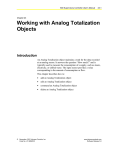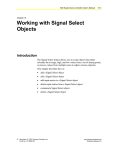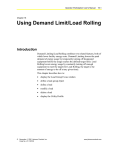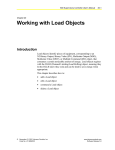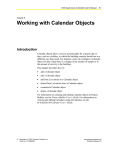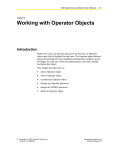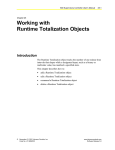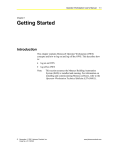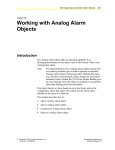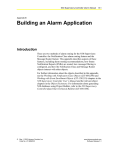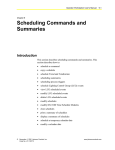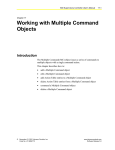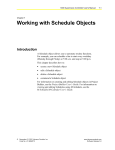Download N30 Supervisory Controller User`s Manual: Chapter 24: Working
Transcript
N30 Supervisory Controller User’s Manual 24-1 Chapter 24 Working with Event Totalization Objects Introduction The Event Totalization object tracks the number of events or pulses over time, meaning it counts the number of transitions in an object’s value. This chapter describes how to: • add an Event Totalization object • edit an Event Totalization object • command an Event Totalization object • delete an Event Totalization object © November 01, 2001 Johnson Controls, Inc. Code No. LIT-6892240 www.johnsoncontrols.com Software Release 5.0 24-2 N30 Supervisory Controller User’s Manual Key Concepts Event Totalization Object An Event Totalization object records a total for the number of times any binary event has occurred. Unlike the other types of totalization, Event Totalization updates its Present Value output each time an event occurs, instead of calculating the value every minute. The Event Totalization object can be added to any container or object in the hierarchy. The Event Totalization object references any object and one of its attributes for input data calculations. Note: The Input Reference of an Event Totalization object should refer to enumeration or Boolean based attributes in order to perform as intended. Event Totalization objects referencing other attribute data types (e.g., floating point) yield unusual results, though not necessarily unusable results. Neither the VT100 nor Project Builder give an error message when this object is attached to any attribute other than enumeration or Boolean based attributes. Typical uses for Event Totalization are determining: • how many times a motor started • how often a sensor was in alarm • how many cars entered a parking lot The Event Totalization formula and an example are illustrated in Table 24-1. Refer to the Attributes section of this chapter for information about attributes used in the calculation. Table 24-1: Event Totalization Formula and Example Calculations Event Totalization Calculation Formula Present Value + (Value per Pulse/Scalefactor) = Present Value (New) Example 1 person + (1/1) = 2 persons (Occupancy) N30 Supervisory Controller User’s Manual 24-3 Event Totalization Object Reset Describes under what conditions the reset of the Event Totalization object occurs and what conditions result due to the reset. Table 24-2: Event Totalization Reset Reset Conditions Occurs: • When a Reset Command is received. • When the following attributes are rewritten: Low Cutoff Value Timebase Scalefactor Reset Totalize Limit, when the Present Value has reached the currently defined Totalize Limit value Rollover, when the Present Value has reached the currently defined Totalize Limit value • Following a return from a Totalization object’s disabled state to an enabled state • Termination of ongoing calculations • Restoration of the Present Value and Rollover Count values to their initial states • Retriggering of all Change-of-Value state changes Results In: Attributes The values of an object’s attributes determine how the object operates. The Event Totalization object attributes described below are listed in the order that they appear on the screen. Entry requirements for these attributes are in Table 24-4. For additional information about the Event Totalization object and its attributes, refer to Object Dictionary. Object Name Identifies the object on the user interface. Description Provides optional information to further describe the object. Object Type Indicates the kind of object, such as Schedule, N2 Analog Input, or Event Totalization. 24-4 N30 Supervisory Controller User’s Manual Object Category Determines the general classification of an object to help define user access capability and message routing. Enabled Indicates if the object is active and executing an operational condition. Input Reference Specifies the object and attribute totalized by this object. If this attribute is unreliable, totalization is temporarily suspended. Reference Defines the state (0-31) in which the Input Reference attribute must be for totalization to be active. Writing this attribute forces the Reset condition. Value Per Pulse Indicates the unit value of the Input Reference for pulse totalization. For the event totalization, the value is 1. Writing this attribute sets the Reset condition. Transition Defines which transitions should be counted. If the value is Entering State, it counts the number of transitions into a given state as indicated by the Reference attribute. If the value is Count All, it counts all state transitions. Writing this attribute sets the Reset condition. Scalefactor Indicates the value used to scale the totalized value to either a larger or smaller value than would otherwise result. Writing this attribute sets the Reset condition. Totalize Limit Defines a threshold value the Present Value must meet or exceed in order for the totalization object to take special action. The special action taken depends on the setting defined for the Rollover attribute. Rollover Defines the special action the totalization object must take when the Present Value reaches the Totalize Limit value. If the Rollover attribute is set to False, the Runtime Totalization object ceases further operation when the Present Value equals or exceeds the Totalize Limit value. If it is True, it will reset the Present Value to 0.0 and resume a new cycle of totalization. N30 Supervisory Controller User’s Manual 24-5 Units Indicates the measurement units of this object. Display Precision Indicates the rounded position and decimal places to display for this object. Present Value Represents the current totalized value of the object. Writing this attribute forces the Reset condition. Present Value appears to the right of the object name in the container hierarchy after the object is created. Reset Forces a Reset condition, after a write of this attribute to True. The reading of this attribute always returns a False condition. It is not displayed on the attributes screen but it is useful for advanced diagnostics. Rollover Count Indicates how many rollovers have occurred since the object started totalization, when the Rollover attribute is True. This is an internal attribute value. It is not displayed on the attributes screen but it is useful for advanced diagnostics. 24-6 N30 Supervisory Controller User’s Manual Procedure Overview Table 24-3: Working with Event Totalization Objects To Do This Follow These Steps: Add an Event Totalization Object Browse to and highlight the container or object where the Event Totalization object is to be added. Press the F3 (Add) key. Select Event Totalization and press Enter. Fill in the fields using Table 24-4. Press the F3 (Save) key. Check the User Assistance area of the screen to verify if the save was successful or if there were errors. Press any key to continue. Press the F4 (Cancel) key to return to the container hierarchy. Edit an Event Totalization Object Browse to and highlight an Event Totalization object. Press Enter to open the object. Press the F3 (Edit) key. Edit the fields using Table 24-4. Press the F3 (Save) key. Check the User Assistance area of the screen to verify if the save was successful or if there were errors. Press any key to continue. Press the F4 (Cancel) key to return to the container hierarchy. Command an Event Totalization Object Browse to and highlight an Event Totalization object. Press the F2 (Command) key. Use the Spacebar and the Backspace key to cycle through the list of commands until the desired command appears. Press Enter. Delete an Event Totalization Object Browse to and highlight an Event Totalization object. Press Enter to open the object. Press the Delete key. Press the Tab key to confirm the deletion. N30 Supervisory Controller User’s Manual 24-7 Detailed Procedures Adding an Event Totalization Object To add an Event Totalization object: 1. Browse to and highlight the container or object where the Event Totalization object is to be added. 2. Press the F3 (Add) key. The Add Object list appears. 3. Select Event Totalization and press Enter. The Event Totalization object attribute screen appears (Figure 24-1). Figure 24-1: Event Totalization Object Attribute Screen 4. Fill in the fields using Table 24-4. 24-8 N30 Supervisory Controller User’s Manual Table 24-4: Attribute Entry Requirements Screen Area Attribute Required Default Options/Range Object Object Name No Blank Maximum 32 characters Invalid characters: @ . ? * $ # : ’ [ ] If not completed, the system assigns a name. Description No Blank Maximum 40 characters Object Type Yes Event Totalization The default is preset and cannot be changed. Object Category Yes HVAC Use the Spacebar and Backspace key to view and select options: HVAC, Fire, Security, Services, Administrative. Enabled Yes True Use the Spacebar and Backspace key to view and select options: True, False. Input Reference Yes Reference Yes State 0 Use the Spacebar and Backspace key to cycle through the list of options: 0 to 31. Value Per Pulse Yes 1 A float value equal to or greater than 0 Transition Yes Entering State Use the Spacebar and Backspace key to cycle through the list of options: Entering State, Count All. Scalefactor Yes 1.0 A float value greater than 0 Totalize Limit No Blank A float value greater than 0 Rollover Yes False Use the Spacebar and Backspace key to view and select options: True, False. Units Yes Blank Use the Spacebar and Backspace key to view and select options. Refer to Units Enumeration Set in Appendix A: Object Enumeration Sets of the Object Dictionary (LIT-694980). Display Precision Yes 1s Use the Spacebar and Backspace key to view and select options. Refer to Display Precision Enumeration Set in Appendix A: Object Enumeration Sets of the Object Dictionary (LIT-694980). Engineering Values Display If this Event Totalization object is being added to a container, the exact name of the object and attribute to be totalized must be entered. If this Event Totalization object is being added to another object, the name of that object appears automatically with its Present Value attribute. Example: HEATING SP.Present Value. Present Value is the default attribute that appears. 5. Press the F3 (Save) key. 6. Check the User Assistance area of the screen to verify if the save was successful or if there were errors. If errors were detected, correct them and resave the entries. Once the save is successful, continue with Step 7. 7. Press any key to continue. 8. Press the F4 (Cancel) key to return to the container hierarchy. N30 Supervisory Controller User’s Manual 24-9 Editing an Event Totalization Object To edit an Event Totalization object: 1. Browse to and highlight an Event Totalization object. 2. Press Enter to open the object. Note: Additional attributes appear. Refer to the Object Dictionary for more information. 3. Press the F3 (Edit) key. The Event Totalization object attribute screen appears (Figure 24-1). 4. Edit the fields using Table 24-4. 5. Press the F3 (Save) key. 6. Check the User Assistance area of the screen to verify if the save was successful or if there were errors. If errors were detected, correct them and resave the entries. Once the save is successful, continue with Step 7. 7. Press any key to continue. 8. Press the F4 (Cancel) key to return to the container hierarchy. Commanding an Event Totalization Object To command an Event Totalization object: 1. Browse to and highlight an Event Totalization object. 2. Press the F2 (Command) key. The Command field appears. 3. Use the Spacebar and the Backspace key to cycle through the list of commands until the desired command appears. The Event Totalization object supports the commands identified in Table 24-5. Table 24-5: Supported Commands Command Description Reset Resets the Present Value to zero. Enable Instructs the Event Totalization object to start event totalizing the Input Reference object. Disable Instructs the Event Totalization object to stop event totalizing the Input Reference object. 4. Press Enter. 24-10 N30 Supervisory Controller User’s Manual Deleting an Event Totalization Object To delete an Event Totalization object: 1. Browse to and highlight an Event Totalization object. 2. Press Enter to open the object. 3. Press the Delete key. 4. Press the Tab key to confirm the deletion. N30 Supervisory Controller User’s Manual 24-11 Troubleshooting When configuring an Event Totalization object with a Multistate Value object, the user can inadvertently specify a value for the Reference attribute that is unobtainable within the Multistate Value object. The Reference attribute dictates the state in which the targeted object has its specified events recorded. This situation occurs because the user is prompted with a generic list of state selections ranging from State 0, State 1, State 2, all the way up to State 31, when queried for the Reference value. Because this initial selection list is not directly derived from the targeted Multistate Value, it is possible for the user to select a value that actually falls outside the range of values defined for the Multistate Value object. Table 24-6 lists examples of potential problems and suggested solutions. Table 24-6: Event Totalization Multistate Configurations Configuration Explanation Solution The Multistate Value object is configured as follows: State 0, State 1, State 2, and State 3 are the only legitimate values that the Multistate Value object can attain. Since the Multistate Value object cannot enter State 4, the Event Totalization object can record any events and its Present Value remains at 0. No error message displays and the Event Totalization object’s Executing attribute displays Active, despite an unobtainable value being entered. The state specified for the Reference attribute of the Event Totalization object must be a state that can be legitimately achieved by the Multistate Value object. Legitimate selections for the Event Totalization object include: State 0 (Occupied) State 1 (Unoccupied) State 2 (Startup) State 3 (Shutdown) Since State 4 falls outside the range of legitimate Multistate Values, the Event Totalization object is inoperable. State 4 also falls outside the range of legitimate States Text values. Examination of the Event Totalization object via the VT100 results in the terminal beeping and the Reference attribute value displaying a “?”. Edit the Event Totalization object using the steps described in the Editing an Event Totalization Object, highlight the Reference attribute field and press the Spacebar or Backspace key. This action forces a presentation of the attainable values, given the value of the Multistate Value object’s States Text attribute. The compatible value can then be chosen from the values presented. • Number of States attribute = 4 • States Text attribute = States (value ranges from State 0 to State 31) The Event Totalization object is configured as follows: Reference attribute = State 4 The Multistate Value object is configured as follows: • Number of States attribute = 4 • States Text attribute = HVAC Mode (Startup, Shutdown, Occupied, Unoccupied) The Event Totalization object is configured as follows: Reference attribute = Any available options: State 0 through State 31 Continued on next page . . . 24-12 N30 Supervisory Controller User’s Manual Configuration (Cont.) Explanation Solution The Multistate Value object is configured as follows: Legitimate selections for the Event Totalization object include: State 0 (Occupied) State 1 (Unoccupied) State 2 (Startup) Since State 3 falls outside the range of legitimate Multistate Values, the Event Totalization object is inoperable. However, State 3 falls within the legitimate range of HVAC mode values, so the examination of the Event Totalization object via the VT100 does not result in the terminal beeping nor the Reference attribute value displaying a “?”. The state specified for the Reference attribute of the Event Totalization object must be a state that can be legitimately achieved by the Multistate Value object. • • Number of States attribute = 3 States Text attribute = HVAC Mode (Startup, Occupied, Unoccupied are possible. Shutdown is not achievable by the Multistate Value object.) The Event Totalization object is configured as follows: Reference attribute = State 3 (This correlates to Shutdown.) IMPORTANT: It is recommended to set the Reference attribute of a new Event Totalization object being configured with a Multistate Value object to an initial selection of State 0. This guarantees that no matter which States Text set is employed by the Multistate Value object, the value falls within the legitimate range. After creating the Event Totalization object, go back and edit the Reference attribute to the required State. This allows the presentation of legitimate values given the Multistate Value object’s States Text attribute.












